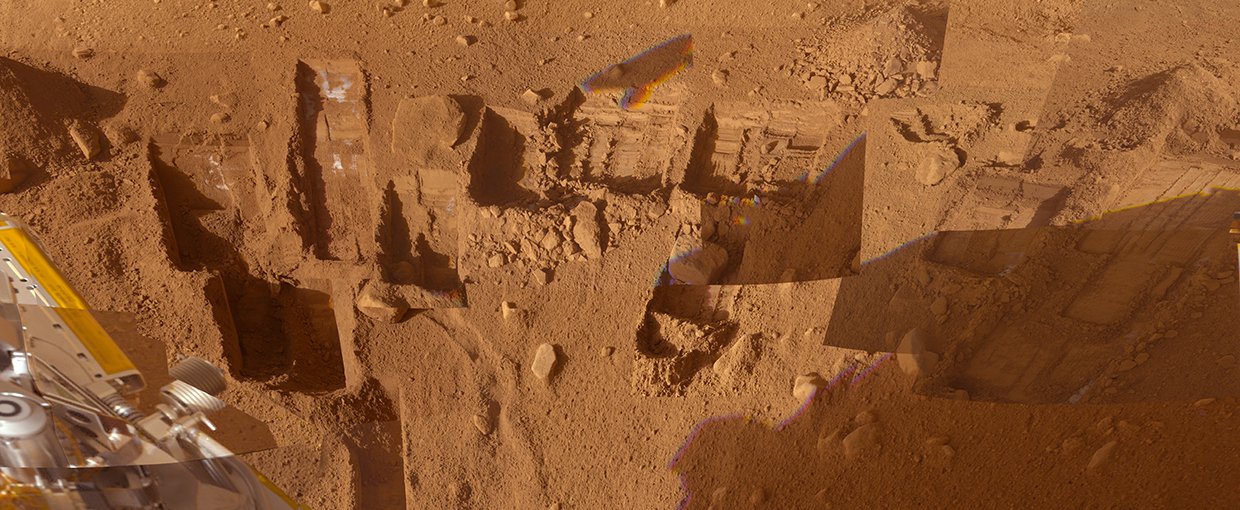
Huge escarpments of quite pure water ice have been found in the Southern Highlands of Mars — accessible enough that astronauts might some day be able to turn the ice into water, hydrogen and oxygen.
Some of these deposits are more than 100 meters thick and begin only a meter or two below the surface.
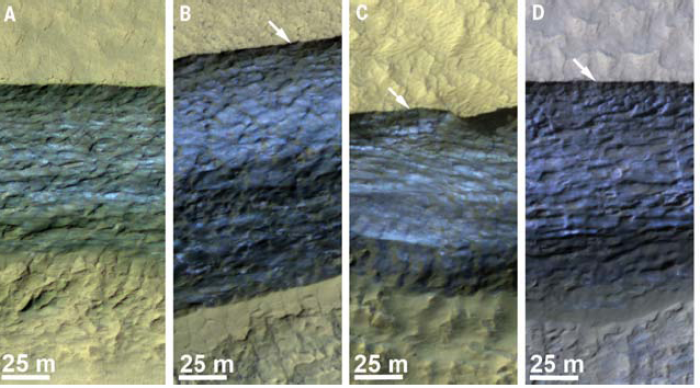
Enchanced-color traverse section of martian icy scarps in late spring to early summer. Arrows indicate locations where relatively blue material is particularly close to the surface. Image taken by HiRISE camera on Mars Reconnaissance Orbiter.Image credit: NASA/JPL/UNIVERSITY OF ARIZONA/USGS.
These are among the conclusion from a new paper in the journal Science that describes these previously unknown water ice reserves. While Mars scientists have long theorized the presence of subsurface ice under one-third of the planet, and even exposed bits of it with the Phoenix lander, the consensus view was that martian ice was generally cemented with soil to form a kind of permafrost.
But the “scarp” ice described by Colin Dundas of the U.S. Geological Survey and colleagues is largely water ice without much other material. This relative purity, along with its accessibility, would make the ice potentially far more useful to future astronauts.
“The ice exposed by the scarps likely originated as snow that transformed into massive ice sheets, now preserved beneath less than 1 to 2 meters of dry and ice-cemented dust or regolith,” the authors write. The shallow depths, the write “make the ice sheets potentially accessible to future exploration.”
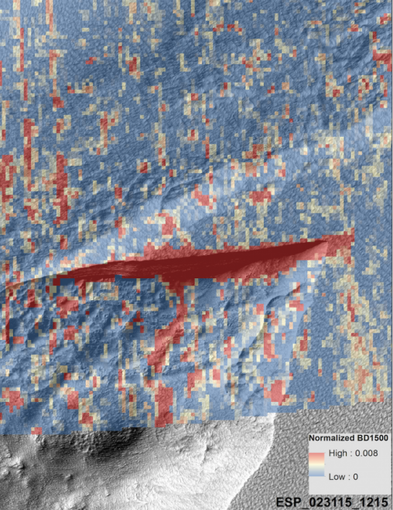
The bright red regions contain water ice, as determined by measurements by the High-Resolution Imaging Science Experiment (HiRISE) on NASA’s Mars Reconnaissance Orbiter.Image credit: NASA.
The importance is clear: These sites are “very exciting” for potential human bases as well, says Angel Abbud-Madrid, director of the Center for Space Resources at the Colorado School of Mines in Golden, who led a recent NASA study exploring potential landing sites for astronauts.
Water is a crucial resource for astronauts, because it could be combined with carbon dioxide, the main ingredient in Mars’s atmosphere, to create oxygen to breathe and methane, a rocket propellant. And although researchers suspected the subsurface glaciers existed, they would only be a useful resource if they were no more than a few meters below the surface. The ice cliffs promise abundant, accessible ice, Abbud-Madrid told
While the discovery adds to the view that Mars is neither bone-dry now nor was earlier in its history, it does not necessarily add to the question of where all the martian water has gone or how much was originally there.
That’s because the paper describes the huge ice deposits as the result of snowfall over more recent eons that was packed into its current form, rather than water that might have been present during the warmer wetter periods of Mars history. With this in mind, Dundas said in an email that his team’s work does not add to what is known about the early Mars water budget.
As for the age of the water ice, he said “we can’t put an accurate number on it at this time, but the icy units are lightly cratered. Others in the community have proposed snowfall during periods of high axial tilt within the last few million years.”
So the ice is relatively young. But that doesn’t mean it has no story to tell. Exposed ice, like exposed rock, always has a story to tell.
“We expect the vertical structure of martian ice-rich deposits to preserve a record of ice deposition and past climate,” the authors write.
The eight scarps studied were steep and faced the poles. All were in the mid-latitudes, and therefore far from the polar ice sheets.
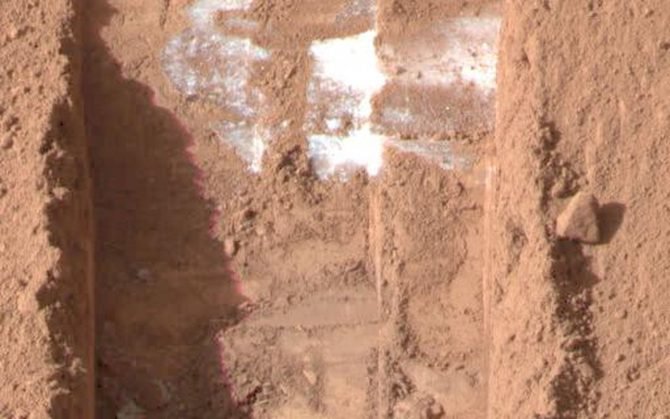
The lander Phoenix dug into the soil of the northern polar region and found cemented ice as well as pure ice several inches down.Image credit: NASA.
NASA has long had a motto for exploring Mars and other sites beyond Earth of “follow the water.” That has been expanded to “follow the carbon” and “follow the organics,” but the water is still a guidepost of sorts of where life, or its remnants, might be found. Now with these large and seemingly accessible deposits of water ice, “follow the water” takes on a new meaning for potential future astronauts in search of essential chemical components.
Still, the issue of just how much water there is and has been on Mars is a central to piecing together the planet’s history and how much of the planet might have one day been eminently habitable.
The last decade of Mars exploration and observation has led most Mars scientists to conclude that the planet once had rivers, lakes and possibly a northern ocean. That water is almost entirely (or perhaps entirely) gone from the surface now, and understanding where it went is certainly key to understanding the history of the planet.
While much no doubt escaped to space after the early protective Mars magnetic field and atmosphere largely disappeared, researchers say there remains a lot of Mars water to be accounted for.
An article in the journal Nature last month reported the possibility of large amounts of water mixing with martian basalts long ago and forming a broadly water-rich crust. The authors of that paper, led by Jon Wade of Oxford’s Department of Earth Sciences, described modeling that found water on early Mars could be absorbed into spongy rock at a far greater rate than on Earth.
In an accompanying review, geochemist and cosmochemist Tomohiro Usui of the Earth-Life Science Institute in Tokyo, supported the notion, and added another possibility that he has published on as well.
“Ground ice might also account for the missing water reservoir on Mars,” he wrote. “Subsurface radar-sounder measurements have detected an anomaly in an electrical property of rocks in the planet’s northern hemisphere, which implies that massive ice deposits are embedded among or between layers of sediment and volcanic materials at a depth of 60–80 m.”
Usui wrote that the ground-ice model has also been proposed based of analyses of hydrogen isotopes in martian meteorites and of the shapes and characteristics of craters. Indeed, the crater study indicated that the subsurface water ice has a volume comparable to the size of the ancient oceans.
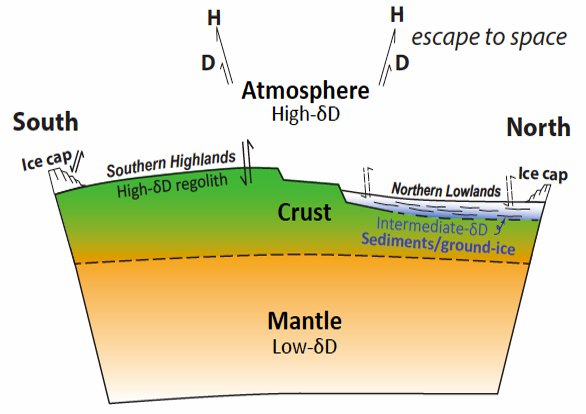
Where did the large amounts of water once present on Mars go. Some clearly was lost to the atmosphere, but some researchers are convinced that much is underground as ice or incorporated into minerals.Image credit: Nature.
Dundas agreed that the new paper was a continuation of earlier work, rather than something entirely new. “We’ve known for some time that there is shallow ground ice within a meter of the surface, and there have been recent radar detections of ice sheets tens of meters thick,” he said in his email. “What our work does is provide some three-dimensional information at high resolution that helps tie things together.”
Dundas et al reported that the fractures and steep angles found indicate that the ice is cohesive and strong. What’s more, bands and variations in color suggest that the ice contains distinct layers, which could be used to understand changes in Mars’ climate over time.
Because the ice is only visible where surface soil has been removed, the paper says it is likely that ice near the surface is more extensive than detected in this study.
And that could be very important to astronauts on future missions to Mars.

